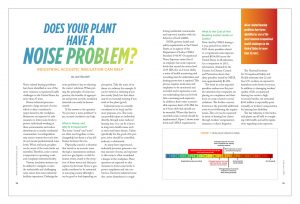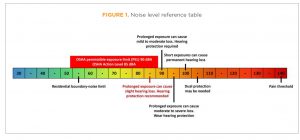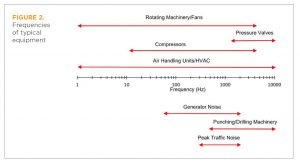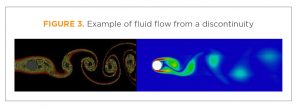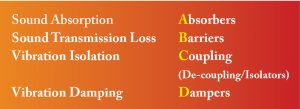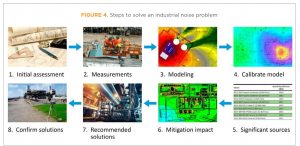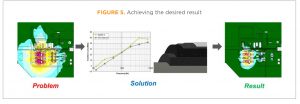Does Your Plant Have a Noise Problem? Industrial Acoustic Insulation Can Help
Noise-related hearing problems have been identified as one of the most common occupational health challenges in the United States for more than 25 years.
Heavy industrial processes generate a large amount of noise, which is often considered a major hazard in the workplace. Businesses are expected to take measures to lower noise levels to protect individuals working in these environments and reduce disturbances to nearby residential communities. Local legislation may exist to ensure that such sites do not exceed predetermined noise levels. When enforced, penalties can be severe if the noise limits are exceeded. Therefore, noise control is important in operating a safe and compliant industrial facility.
Various insulation systems can be utilized to mitigate or solve the undesirable and challenging noise issues that some industrial facilities experience. Defining the noise problem is key to selecting the correct solutions. When putting the principles of noise into practice, the benefits of appropriate and proven acoustic insulation materials can easily be demonstrated.
If the answer to the question “do you have a noise problem?” is yes, acoustic insulation can help.
What Is Noise, and Why Is it Important?
The terms “sound” and “noise” are often used together or interchangeably, but there is a key difference between the two.
Physically, sound is a vibration that travels as an acoustic wave through a transmission medium such as a gas, liquid, or solid. In human terms, sound is the reception of these waves and their perception by the brain. Noise is generally considered to be unwanted or annoying sound, although it can be good or bad depending on perception. Take the noise of an alarm at a refinery, for example. It can be viewed as irritating if you live nearby (bad), but that alarm may be an essential warning if you work at the plant (good).
Industrial noise is normally considered to be loud; and for most purposes, it is. This noise can possibly injure an individual directly, through noise-induced hearing loss, or it can be a factor in long-term health issues such as stress and heart disease. Unless specifically for the good of its purpose, noise should be controlled, reduced, or eliminated.
As many have experienced, industrial processes generate a certain amount of noise, and exposure to this noise is often considered a danger in the workplace. Plant operators are expected to take measures to lower noise levels to protect employees and site contractors. Excessive industrial noise also causes disturbance to neighboring residential communities and may even interfere with the behavior of local wildlife.
OSHA governs health and safety requirements in the United States, as an agency of the Department of Labor. OSHA Standard 1910.95–Occupational Noise Exposure states that if an employer has noise-exposure levels that exceed the action level of 85 dBA (for an 8-hour shift), a series of health monitoring and recording must be undertaken, and hearing protection is required. This process requires work areas and employees to be monitored and recorded, and it represents a serious undertaking that can be both time consuming and expensive. In addition, there exists a permissible exposure limit of 90 dBA for an 8-hour shift that should not be exceeded. Where this limit is exceeded, noise controls should be implemented. Figure 1 shows noise levels and OSHA requirements.
What Is the Cost of Not Meeting Action Levels or Limits?
Data cited by OSHA during a 1-year period from 2020 to2021 shows penalties related to occupational noise exposure around $834,000 across the United States in all industries.
As a comparison to 2015,information obtained by the Centers for Disease Control and Prevention shows that these penalties issued by OSHA were approximately $1.4M.
The trend in noise-exposure penalties underscores the positive attention that companies are placing on compliance and their focus on noise control to avoid violations. The further concern, however, is the potential additional costs for not following the requirements. This cost can be measured in terms of hearing loss claims through workers’ compensation insurance or direct litigation.
The National Institute for Occupational Safety and Health estimates that 22 million U.S. workers are exposed to hazardous noise levels every year. In addition to damaging workers’ quality of life, occupational hearing loss carries a high economic burden. An estimated $242 million is reportedly spent annually on workers’ compensation for hearing loss disability.
The key takeaway is that industrial plants are all held to complying with health and safety regulations regarding noise exposure.
How and Where Is Noise Being Generated?
Each sound source has its own sound fingerprint and frequency characteristics. When selecting noise control, it is necessary not only to establish what the total sound level is, but also what frequency characteristics are contributing to that overall level. By understanding the fingerprint of the sound sources that require noise control, it is possible to determine the required solutions. Figure 2 provides frequencies for common industrial sound sources.
How Does Piping Create Noise? What Mechanisms Are Behind This Generation?
Sound emitted by pipework is created by the vibration of that pipework creating an acoustic disturbance in the air around it, affecting the areas around the pipework. This can then be an issue for occupational noise exposure or environmental noise concerns, regulation, planning, etc. It is the job of insulation to minimize this sound transmission.
Process piping is an important noise source that should be evaluated, as it can represent up to 50% of the total noise generated on an industrial site. But why is pipework so noisy?
Pipes are used to transport fluid media, and they are attached to machinery that drive such media. Typically, these machinery items are compressors, pumps, or blowers. The physical, structural connection of the pipes to the rotating driver equipment causes the pipe wall to vibrate. The action of the fluid flow through a pipe also causes the pipe wall to vibrate.
Pulsation and cavitation from the machinery is transmitted through the fluid to the pipe. Additionally, the action of introducing bends, rough pipe walls, and discontinuities such as pressure gauges, tees, or strainers all have the effect of disturbing the smooth fluid flow.
These items introduce disruptions that cause unsteady flow—vortices, essentially. Figure 3 demonstrates how discontinuities affect the fluid flow. These “eddies” creates a pressure wave inside the pipe that makes the pipe wall vibrate. An eddy is the swirling of a fluid and the reverse current when the fluid is in a turbulent flow regime.
All these mechanisms can cause the pipe to vibrate and become a significant sound generator, particularly if the sound generation is in harmony with resonant behavior of the pipe. As we know, this pipe vibration causes the propagation of sound via an acoustic wave to the areas around the pipe.
Because the pipe itself vibrates, the application of insulation onto the pipe is aimed to block the airborne sound. However, it is also essential to stop structure-borne noise elements from reaching the insulation cladding, as it can re-radiate as a secondary airborne noise element.
Industry Standards for Acoustic Insulation Materials
There are several U.S. and international standards that allow for the standardization of testing and certifying acoustic materials for their ability to absorb and restrict the passage of sound in different circumstances. By understanding the nature of the sound or noise you are trying to reduce, you can understand the frequencies of the sound level that need to be reduced. It is necessary to use the correct material characteristics that match the frequencies you are trying to attenuate.
Depending on the use of the materials and the function they will be required to operate under, the test and reported parameters will be different. For example, we commonly hear of a material needing to meet a sound transmission class (STC). This parameter is used to describe the ability of a material to restrict the passage of airborne sound through it. The higher the STC, the better the material is at preventing sound from passing through it. This parameter is not, however, a useful factor when looking to reduce pipe noise.
When applying a covering over a noise source, such as insulation onto a pipe, it is necessary to account for the airborne sound emitted by the vibrating pipe; but it is also necessary to isolate the insulation cladding from the pipe wall to prevent structure-borne transmission from pipe to cladding. If the structure-borne element is not considered, the vibration of the pipe transfers to the cladding and is re-radiated as a secondary airborne acoustic emission.
Most commonly, design specifications reference the International Organization for Standardization (ISO) 15665 regarding acoustic insulation system requirements. ISO 15665 is an international standard that defines the “insertion loss” acoustic performance of pipe insulation and classifies the material accordingly. Insertion loss in this context is the difference, in decibels, in the sound level radiated from a noise source before and after the application of the acoustic insulation. This parameter accounts for both the airborne and structure-borne components. The standard also specifies the test procedure to determine the acoustic performance. For pipework, the ASTM E1222 standard sets forth the same test method as ISO 15665 but does not describe any classification of the results.
To receive a class rating, ISO 15665 establishes a specific set of insertion loss requirements the system configuration must meet at specified octave bands. This performance is categorized into classes A, B, C, and D, based on measured acoustic insertion loss. Class D is classified according to the Shell DEP #31 specification. As the size of the pipe increases, it becomes more difficult to meet the insertion loss requirements of ISO 15665 and the system design will typically be more complex. Table 1 (on the next page) shows the minimum insertion loss requirements to meet the various classifications.
To determine the insertion loss, a sound source is applied to the inside of a steel pipe. The pipe passes through a reverberant test room. With just the bare pipe, the diffuse sound in the test room is measured. An insulation material or system is then applied to the pipe in the room. The test is repeated. Comparing and subtracting the results of the bare pipe from the insulated pipe gives an insertion loss—simply put, a reduction in sound level.
This standard helps noise control engineers select the correct insulation system during the design stage to ensure that specified noise targets are met.
Insulation Material Characteristics Important for Noise Control Success
The secret to success is typically an engineered, multi-layer insulation system coupled with an understanding of how component materials will behave when used together to solve a noise problem.
Various types of insulation system materials may be used to control both airborne and structure-borne noise transmission. These material properties may be split into the following four categories:
Absorption and barrier materials control airborne noise transmission. Damping and isolation (de-coupling) materials control structure-borne noise transmission. Absorbers soak up sound energy waves, barriers provide a physical obstacle to impede sound transmission via reflection, de-coupling isolates the vibration from a structure, and dampers absorb vibration energy. For airborne transmission attenuation, the insulation is ideally sound absorbing, limp, and heavy, and will have a good degree of damping. For structure-borne transmission attenuation, the material must have a low dynamic stiffness and a high degree of damping.
Common insulation materials used for industrial acoustic applications are insulation systems based on fibrous materials (mineral fiber, glass fiber, and rock fiber), flexible elastomeric foam (FEF), or aerogel.
Mineral wool and aerogel materials can provide effective acoustic de-coupling/isolation and sound absorption. Their low dynamic stiffness (being non-rigid and soft) and optimized air flow resistance provide excellent acoustic absorption across a wide frequency range. For airborne sound absorption, it is necessary to have an open-cell material layer that provides a tortuous route for the sound pressure wave to travel, losing energy as it passes through. This is achieved within the blankets of the aerogel and mineral wool.
FEF insulation is a flexible material that is offered in both closed-cell and open-cell grades, each with its own unique acoustic benefits. Contrary to the general market understanding regarding their use as acoustic insulation materials, closed-cell FEF materials are in fact a key component in providing effective acoustic de-coupling/isolation. Open-cell FEF is a higher density material with inherent damping ability that has excellent sound absorption behavior across the entire frequency range. Using the separate closed- and open-cell FEF materials in tandem provides the same overall insertion loss performance as singular aerogel or mineral wool materials.
None of the above materials provide sufficient mass in the system to act as an effective barrier. The use of a material such as a mass-loaded vinyl barrier mat and/or a high mass cladding is often necessary. With their high density, mass barrier products combine minimum thickness with an excellent reduction of the transmission of airborne sound, while enhancing the insertion loss performance of the system.
While materials such as polyisocyanurate or cellular glass are regularly used in cold/cryogenic applications for thermal protection, such materials are rigid; and although they may provide some reduction in the airborne transmission, their structure-borne transmission causes an ineffective acoustic insulation performance. Insulation should be layered on top for acoustical purposes.
When incorporating rigid thermal insulation materials in the acoustic system design, using two separate insulation materials (one on top of the other) leads to a large thickness of insulation on the pipework; thus, the effective diameter and circumference of the pipe is increased. This may seem inconsequential; however, this effect can increase the generation of lower frequency acoustic emissions.
Pipework insulation systems do not generally work well at attenuating these low-frequency emissions. This means that where a facility has specific environmental noise requirements, it may be difficult to get the noise reductions needed to meet those requirements. Testing using method ASTM E1222 can help provide data and then insulation materials can be selected to mitigate the targeted frequency.
Where possible, the use of a single, flexible, thermal-acoustic insulation material system can be preferable, as it minimizes these issues. Developments in advanced material systems are challenging the traditional systems and alleviating the problems they may cause. While various insulation materials are available to help with noise reduction, designing a single thermal-acoustic insulation solution may deliver high-performing noise control for pipework while minimizing thickness and total weight, and providing superior protection against the risk of CUI (when compared to traditional systems).
Solving an Industrial Noise Problem
To understand a noise issue, it becomes necessary to frame the problem: What is driving the noise problem? Why was it perceived to be a problem? Is it a health and safety issue or an environmental disturbance? In short, what is the ideal target to say the problem is solved? The solution process is represented in Figure 4.
Merely saying that an area is noisy and needs noise control is a good start, but to get the desired solution, it is necessary to fully understand what that solution looks like. Do you know what sound level is acceptable? Does a solution have a fixed budget? Are there operability, maintenance, and inspection requirements? All these parameters need to be considered in selecting an effective noise control method that specifically fits the noise “fingerprint.”
Once the target sound level is known, you can start to investigate the cause of the problem. Ideally, it becomes necessary to make some detailed sound level measurements in and around the area of concern to get to the bottom of what is causing the issue.
Multiple sound sources create an overall sound environment. Only through detailed measurement techniques is it possible to break down all the necessary sound components that require attention. Once all the components have been categorized, a simulation of the problem can be created.
This simulation should provide a calibrated acoustic model that will accurately recreate the situation at hand. The simulation will be able to clearly show which of the system components are causing the problem and need to be addressed. Subsequently, each component can have a noise control (insulation system) solution applied to it. The simulation can then demonstrate the degree to which mitigation is successful.
Once noise control elements required to meet the target sound levels are selected, discussions should be held to establish the suitability of the solutions. Elements such as operability, maintenance, inspection, and cost should be discussed and explored.
Following this process will help to ensure that the best possible noise control solution has been selected and applied to any given situation. Not only does this approach work, but it should yield the best possible outcome for the cost—creating an efficient, effective solution (Figure 5).
Conclusion
Acoustics may not be considered a primary design consideration, but pipework represents a significant source (up to 50%) of the total noise on an industrial site. Therefore, this is clearly a key area worth investigating and it is being regulated more frequently.
Acoustic insulation systems based on aerogel, mineral wool, and FEF have the necessary characteristics to control both airborne and structure-borne noise. These non-rigid, flexible materials are proven acoustic components in systems that effectively meet the various insertion loss requirements and classifications outlined in the ISO 15665 standard and Shell DEP specification.
Manufacturers of acoustic insulation materials can work with facility owners to define, understand, and recommend feasible noise control as a whole project solution. By following a proven approach, experts can help identify the cause of noise problems, provide advice and solutions, and demonstrate how those solutions will resolve the issue successfully and efficiently.
Do you have a noise problem? Acoustic insulation can help.

